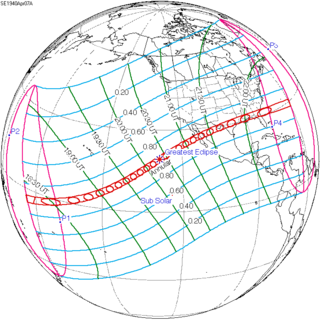| Solar eclipse of April 7, 1940 | |
|---|---|
| Type of eclipse | |
| Nature | Annular |
| Gamma | 0.219 |
| Magnitude | 0.9394 |
| Maximum eclipse | |
| Duration | 450 s (7 min 30 s) |
| Coordinates | 19°12′N 128°30′W / 19.2°N 128.5°W |
| Max. width of band | 230 km (140 mi) |
| Times (UTC) | |
| Greatest eclipse | 20:21:21 |
| References | |
| Saros | 128 (54 of 73) |
| Catalog # (SE5000) | 9375 |
An annular solar eclipse occurred at the Moon's descending node of orbit on Sunday, April 7, 1940,[1] with a magnitude of 0.9394. A solar eclipse occurs when the Moon passes between Earth and the Sun, thereby totally or partly obscuring the image of the Sun for a viewer on Earth. An annular solar eclipse occurs when the Moon's apparent diameter is smaller than the Sun's, blocking most of the Sun's light and causing the Sun to look like an annulus (ring). An annular eclipse appears as a partial eclipse over a region of the Earth thousands of kilometres wide. Occurring about 2.4 days after apogee (on April 5, 1940, at 10:00 UTC), the Moon's apparent diameter was smaller.[2]
Annularity was visible from Gilbert and Ellice Islands (the part now belonging to Kiribati), Mexico and Texas, Louisiana, Mississippi, Alabama, Georgia, Florida, and South Carolina in the United States. A partial eclipse was visible for parts of eastern Oceania, Hawaii, North America, Central America, the Caribbean, and northern South America.
- ^ "April 7, 1940 Annular Solar Eclipse". timeanddate. Retrieved 4 August 2024.
- ^ "Moon Distances for London, United Kingdom, England". timeanddate. Retrieved 4 August 2024.
